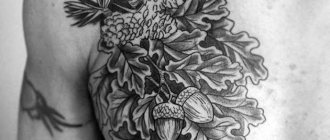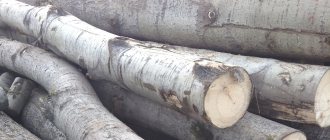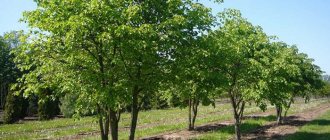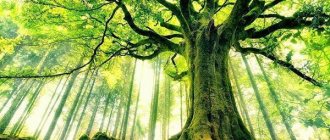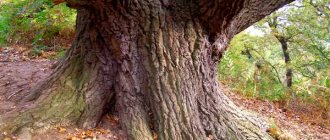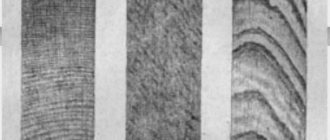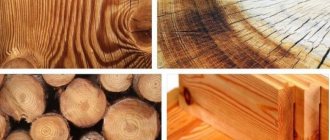Higher plants are divided into herbaceous and woody; accordingly, there are two types of stem structure. A distinctive feature of woody plants is their constant growth in thickness, which stops only when the organism dies. Herbaceous plants are limited in growth due to their life cycle. There are no significant differences in the structure of plant stems.
The stem is the axis of the shoot, with leaves and buds located on it. The structure of the stem can be primary - during the formation of a new plant, when the cells are not yet differentiated (in monocots it remains for life). Dicotyledons and gymnosperms are characterized by rapid changes in the primary stem, as a result of which a secondary stem structure is formed (due to the action of the cambium and phellogen).
Stem
What does the stem consist of?
The structure of the stem of a woody plant includes 5 sections:
- Cork;
- bast;
- cambium;
- wood;
- core.
Cork
In only sprouted plants, the outer layer is represented by a skin, which, over a certain time, is replaced by a cork. The skin protects the stem from moisture evaporation and the action of harmful microorganisms that lead to plant diseases.
Stomata are located on the surface, necessary for effective gas exchange. Direct absorption of oxygen is carried out thanks to lentils - small tubercles on the bark, equipped with a hole. They are formed from cells with large intercellular space. Under the skin there are green cells (they contain chloroplasts). After formation, the corks turn white and are classified as bast.
Functions of the cells of the outer cover of the stem: photosynthesis, protective, gas exchange.
Lub
The bast is divided into soft (includes the conducting system and parenchymal structures) and hard. The color is whitish; the following structural units of the bast are distinguished: sieve tubes, bast fibers, cells of the main tissue.
Sieve tubes are a collection of cells that have many holes on their surface through which organic substances flow.
Bast fibers are mechanical tissue; they have elongated cells with a dense wall. Gives plants flexibility and strength.
Cambium
Between the outer and inner balls of cells there is educational vascular tissue - the cambium. The precambium of the primary structure of the plant serves as the basis for tissue formation.
Cambium cells have an elongated shape, the cytoplasm is colored green, and the nucleus is spindle-shaped. On a section, you can see a circular layer of educational tissue, but true cambial cells form a single-layer ball, because after division only one cell retains the properties of the original one.
Stem structure
What is bast. Meaning of the word
What is bast? How to use this word correctly? What are bast products?
Ask any biologist what bast is, and he will give you a definite answer. In biology, this is what phloem is called. This conducting plant tissue has a complex structure. It is responsible for the transport of organic substances downwards - from the leaves along the tree trunk to its roots. Well, it’s easier to explain to people without a biological education what bast is. This is the name of the inner part of the trunk of any tree.
Internal structure of the stem
Wood
Wood is the main component of the stem . Dense, wide, its composition contains cells of different types and sizes. The following parts are distinguished: vascular tissue, tracheids, wood fibers.
The vessels were formed from connected tubular cells placed on top of each other, the walls between them were partially dissolved, so the liquid could move freely. The main functions of stem vessels are the movement of dissolved salts and nutrients from the root to the leaves and new shoots .
Tracheids are a system of dead cells with intercellular pores through which fluid flows. The rate of movement of solutes is lower than in conducting tissues.
Wood fibers consist of parenchymal cells that accumulate nutrients and thick-walled cells that perform a supporting function.
Core
Core - located in the center of the trunk, formed from large living and dead cells. Living tissue contains tannins. Small cells located near the wood accumulate sugar and starch.
What is the function of the stem core?
The main function of the stem core is to store nutrients necessary for plant growth. The core contains essential oils (beech), resins, tannins (tea bush). In some plants (rhizomes, tubers), the core cells retain the function of a meristem (educational tissue capable of dividing throughout life).
Internal structure of the stem
Sieve tubes
The sieve tubes of tree species do not reveal any special differences. Only here is a stronger development of sieves found. They are located not only on the transverse, but also on the side walls of the sieve tubes. In some tree species (for example, linden) there are complex sieves, and in a staircase-perforated vessel the partition is placed obliquely and consists of a number of sieves separated by transverse crossbars like the rungs of a ladder.
Sieve tubes do not remain alive for very long, only 2-3 years. At a distance of 0.1-0.2 mm from the cambium, they already die off and become clogged with a callosal substance, easily soluble in alkalis. After a few years, when the tubes die, the callosal substance dissolves and the sieves again look like meshes. In the leaves, such dissolution does not occur and the callosal substance is shed along with them. The death of the sieve tubes, of course, does not mean the death of the entire phloem. The bast parenchyma remains alive for a long time - 12-25 years after that. Its cells even grow and divide until they are cut off by a layer of cork.
What functions does the stem perform?
- Supporting - the stem is the core of the plant, provides its support; place for leaves and flowers to grow;
- conductive - transport of dissolved substances from the root system to leaves and branches, new shoots;
- storage – ensures the constant presence of water and nutrients inside the stem;
- protective – protects against the action of dangerous agents and being eaten by animals (spines and thorns develop);
- vegetative propagation - for individual plants (citrus fruits, pineapple) the only way to produce offspring;
- photosynthesis - the presence of chloroplasts in green cells makes it possible to participate in energy conversion processes;
- assimilation of organic substances , for example cacti, in which the stem takes on the function of leaves;
- axial (mechanical) - brings the plant to the sun (leaves - for photosynthesis, flowers - for pollination).
How is wood formed?
Wood is one of the components of the vascular-fibrous bundle; it is opposed to another important part of the bundle, formed from the same procambium or cambium - phloem or phloem. In the process of formation of vascular-fibrous bundles from procambium, two scenarios are possible:
Wood contains already dead cellular elements with woody, mainly thick shells. The composition of bast, on the contrary, is represented by elements of living cells, with living protoplasm, cell sap and a thin non-lignified shell. At the same time, dead, thick-walled and woody elements may be found in the bast.
Both components of the vascular-fibrous bundle have another physiological difference. Raw sap, which is water with useful substances dissolved in it, moves along the wood from the ground to the leaves. But plastic juice flows down through the phloem.
The process of lignification of cell membranes is characterized by the impregnation of the cellulose membrane with special substances, which are collectively called lignin. The presence of lignin and, at the same time, the lignification of the shell can be easily determined using certain reactions. Due to lignification, plant shells grow in thickness and harden. At the same time, with slight permeability to water, they lose their ability to absorb water and swell.
Stem growth
The growth of the stem in thickness occurs due to the presence of educational tissue (cambium).
Favorable conditions for thickening the trunk are the presence of heat and sufficient moisture; in winter, cell reproduction does not occur. The thickness of cadmium does not change during division, since of the two newly formed cells, only one remains in the structure of the educational tissue, and the other moves to wood or bast. The number of cells moving to the central part of the stem exceeds the number of cells reaching the phloem by four times.
The growth rings, which are visible on the cross section of the stem, are formed due to the different shapes of the cells formed in spring and autumn. After spring awakening, cadmium begins to actively divide, forming large cells with thin walls. With the onset of summer, and especially autumn, the cells become smaller. In winter, division of educational tissue does not occur, and in spring the process of reproduction of large-sized cells starts again. This cellular alternation is easily visible in tree sections. Thus, their age is calculated.
Tree rings
Tree rings are used to judge the weather in a particular year . If the ring is wide, then the tree received a lot of moisture and solar heat; if it is narrow, then there was little rain in the spring-autumn period. Also on the south side there is a wider part of the ring because the tree received more heat here.
The growth of the stem in height is carried out using the meristem of the growth cone (apical bud). The cells of the lower part of the cone give rise to the formation of leaves. After which the cells begin to grow, stopping division. The increase in cell size occurs due to the proliferation of vacuoles.
If the stem is broken or artificially deprived of an apical bud, growth in height stops and side shoots begin to develop.
Tree bast
Due to the presence of growth rings, which most tree species form in their trunks during growth, as well as as a result of seasonal fluctuations in temperature or humidity levels, scientists can fairly accurately determine the region in which the tree grew. Annual monitoring of changes in the width of tree rings and analysis of the content of certain isotopes of elements in them makes it possible to study in more detail the state of the climate and atmosphere in ancient times.
Arrangement of leaves on the stem
The areas of the stem where leaves develop are called nodes. Several leaves can grow from one node, this determines their location.
The next thing is that one leaf sprouts from one node; they are placed spirally on the stem and do not interfere with the flow of sunlight to the underlying leaves (birch).
Opposite - two leaves are in the same node, opposite each other (mint).
Whorled - one node has three or more leaves, this arrangement is quite rare (crow's eye).
Arrangement of leaves on the stem
Types of bud arrangement on the stem
Apical - the bud is located at the top of the shoot.
The lateral location is divided into axillary and accessory.
Axillary buds are formed in the axils of the leaves, their number corresponds to the number of leaves on the stem, and adventitious buds are located in the internodal areas, roots, and leaves. With their help, vegetative propagation of plants is carried out.
Bast or primary and secondary bark
The bast conducts organic matter from the crown downwards (downward current) and does not serve to conduct water, since when cutting the bark into a ring around the trunk (ringing), the flow of water to the crown is not interrupted. Mechanical tissues in the bast of tree species always become woody, so woodiness cannot be considered a feature that distinguishes wood from bast.
Like wood, bast also consists of 3 fabrics :
Types of stem growth
There are plants with erect stems - they grow perpendicular to the soil (sunflower, birch);
Creeping - spreading along the ground, taking root in nodes (strawberries);
Climbing – also spreading along the substrate, but not rooting in nodes (hops);
Climbing , having antennae (you can recall the film “Jack and the Beanstalk” and the characteristic appearance of the stem of a bean plant, which, branching, reached the heavens);
Shortened by dandelion and plantain.
Variety of stems
The stem shape is:
- cylindrical;
- triangular;
- multifaceted;
- flattened.
Why does a tree need bast?
The phloem contains layers of living cells similar to cambium, that is, capable of actively reproducing. They are necessary in order to form a protective layer on the outside for the stem cells. Otherwise, the tree would be damaged by any touch, and wounds inflicted on the trunk would lead to the final death of the plant. So the trees protected themselves with natural armor, but not from metal, but from a thin layer of living cells that were formed thanks to the bast.
Thus, a layer of bast in wood is needed for:
In Vasmer Max's dictionary
gen. p, -a “bark, bast”, lubochka “basket made of birch bark”, lubochny, lubyanka “basket, tray, gutter made of bast”, Ukrainian. lube, blr. bast, bulg. bast, serbohorv. lub, gen. n. luba, Slovenian lȗb, Czech. lub, Polish ɫub, v.-luzh., n.-luzh. ɫub. From here the deck. Related Lit. lubà “timber, board”, pl. lùbos “(plank) ceiling”, lúobas “spruce or linden bark”, lt. luba “lub”, Old Prussian. lubo “timber”, lat. liber (from *lubro-) “bast, book”; alb. labе “bark, cork” (Iocles, Stud. 44), ancient Norse. laupr, OE léap “basket, top”, d.-v.-n. louft “bark, bast”, louba “canopy”, Irish. luchtar "boat" (Pedersen, Kelt. Gr. 1, 93); see I. Schmidt, Vok. 1, 159; Bernecker 1, 740 et seq.; Trautman, BSW 150 et seq.; M.–E. 2, 509; Buga, RFV 71, 468; Thorpe 377.
